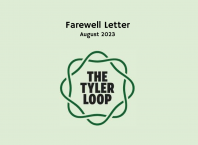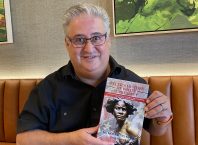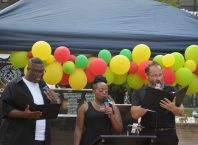
Tyler’s population has been increasing for over 20 years. According to U.S. Census data, Tyler’s population increased 9.38% from 2010 to 2020 — 3.08% percent more than the national average.
Like every community, Tyler must adapt to climate and economic challenges, but the question remains: Will it be enough?
In Part 2 of its development series, The Tyler Loop discusses the ecological impacts of suburban development in Tyler – including south Tyler’s Hamilton Ridge. Part 1 focused on north Tyler’s New Hope Energy recycle plant.
Suburbia and carbon emissions
As Tyler grows, suburban sprawl is among the side effects of the city’s burgeoning population. As far back as the 1940s, white flight drove suburban development locally and nationwide. Since then, Tyler’s economic center has shifted southward.
In the past, segregation and the promises of cheap land drove suburban development. More recently, the desire for lawns, large houses and space are driving forces behind the trend. Early on, people deemed suburban living more sustainable, but data suggests otherwise. According to a U.C. Berkeley study, 50% of all household emissions in the U.S. can be traced back to suburbs.
The environment has borne the brunt of suburban development nationwide, including in East Texas, where development is among the leading causes of habitat loss.
Housing density and carbon emissions are inversely correlated. The denser the housing, the lower the emissions per household. Per the New York Times, carbon emissions decrease 10% in communities with six to eight dwellings per acre, compared with one to two, which is more typical in the suburbs.
What increases carbon emissions in suburbs? Mostly cars and a car-dependent lifestyle. On average, suburbanites drive 31% more than their urban counterparts. Lack of reliable public transportation contributes to the increase.
Like other cities across the country, Tyler’s public transportation system can cause long waits. According to a study conducted on Tyler’s public transportation system, average headways are upwards of an hour. The city has been working on implementing a new plan to remedy these issues by adding new routes, stops and newer electric vehicles.
Bulldozing the Pine Curtain

Throughout East Texas, urban development and industrial practices have driven habitat loss. Eighty-six percent of the southeastern portion of the state has been heavily altered or completely urbanized. Currently, only 3% of the piney woods ecoregion is protected, and 21% of its natural habitat lies outside of protected lands. The ecoregion remains critically endangered according to Terrestrial Ecoregions of North America: A Conservation Assessment.
Tyler’s new growth to its south includes the Hollytree, the Cascades, and the Woods subdivisions. Hamilton Ridge is a newer addition to south Tyler. Construction began in 2015, replacing almost 30 acres of native forest with lawns and concrete.

The location of Hamilton Ridge prior to development in 2015, above, compared to after development in 2021, below.

Prior to development, the area was a vestigial example of pine forest surrounded by low and high density urban landscapes, according to GIS data published in Texas Parks and Wildlife’s Ecosystem Analytical Mapper.
With the exception of bottomland hardwood forests in Rose Rudman, Southside and Faulkner parks along Mud Creek, little green space – public or private – exists in Tyler. The city currently does not have any plans to expand park acreage, said LouAnna Campbell, a public information officer in the city’s Public Works and Utilities department.
Two other large tracts of undeveloped land remain in Tyler’s city limits. In the north, large sections of marshes and forests remain in the vicinity of Black Fork Creek. In the southwest, a section of sandhill and bottomland habitats remains undeveloped.

Additionally, Hamilton Ridge’s model of development differs from other subdivisions in Tyler. Some of south Tyler’s neighborhoods utilize native trees including ashes, magnolias, pines and oaks. By contrast, Hamilton Ridge appears to have few trees. What few are present include callery pears and crepe myrtles, both of which are non-native invasive species. Representatives with the city said they are “not aware of any Callery Pear trees” in the community.
Tyler’s Development Code requires all multifamily developments to preserve pre existing trees or planting new ones to replace those destroyed. Section 10-290 of the Code states doing so is important to “promote the natural ecological, environmental and aesthetic qualities of the city.”

Fifteen percent of the total lot area is required to be landscape to be up to code. Builders are incentivized to preserve pre-existing trees. Each tree saved is counted as 200 ft² for smaller trees and 250 ft². However, tree credits cannot exceed 25% of the landscaped area.
The city prioritizes native species. “The City of Tyler has an approved list of trees in the City Code that builders and contractors refer to when they develop their landscaping plans,” said Campell with the city. “If builders and contractors do not meet the City Code requirements for their landscaping plan presented to the Planning Department, they are not signed off when inspectors look at the property,” she added. However, the list is not binding, as the city “does not have a prohibited list of trees residents and contractors cannot plant.”
Unsustainable and invasive
Tyler’s city codes further prioritize planting native trees and shrubs, recommending “either acceptable native plants to the Tyler area, or plants that are known to be acclimated to the East Texas region.” The code also states, “Trees must be selected so as to avoid those species known to cause damage to public improvements.” Despite this, non-native invasive species are still common in developments across the city.
According to NASA, lawns are severely disrupting water and carbon cycles across the U.S. In the early 2000s, a study published by Environmental Management estimated 163,800 square kilometers of the U.S. are covered by turf grasses. For comparison, the area of the state of Georgia is 153,910 KM².
At the time of the study, 1.6 million homes were constructed per year, and researchers concluded that acreage would significantly increase over time.
A notable absence in Tyler’s landscaping code are regulations pertaining to grasses. Turf grasses and urban landscaping are frequently associated with significant impacts on water quality and the introduction of invasive species. The prevalence of lawns is detrimental in itself.
Wanda W. Rauscher, President of the East Texas Chapter of The Texas Master Naturalists, said lawns function as “ecological wastelands.” “There are so few organisms that are supported by having turf grass that it’s like we’re creating almost a desert for life,” Rauscher said.
Many common plants used in landscaping have far-reaching ramifications beyond the suburbs. Rauscher said the aforementioned Callery pear (also called the Bradford pear), Chinese and Japanese privets, Chinese tallow and Japanese honeysuckle are some of the main species of concern in East Texas.
Some invasive ornamentals, such as the Tree-of-Heaven, support non-native insects that could wreak havoc on ecosystems, such as the spotted lanternfly. The insect was recently sighted in Houston but has yet to move into the region. Per Rauscher and the USDA, it is only a matter of time due to East Texas’ ample habitat. Sightings of the Spotted Lantern Fly should be reported here.
Emerald ash borers are already present in East Texas but have yet to be documented in Smith County. The species “has the possibility of having a huge impact, especially in the city, because people like to plant ash trees because they grow fast,” Rauscher said. The insect “can kill a healthy tree in three years from infestation.” Emerald ash borers are spread by moving wood, including firewood. Sightings can be reported at (866) 322-4512.
Bermuda grass, one of the most common species that comprise lawns in the U.S. South, is considered invasive as well. According to the Texas Invasive Species Institute, the grass spreads rapidly, is drought tolerant and is highly adaptive to a broad range of habitats, making removal more difficult.
To Rauscher, the popularity of lawns is understandable. “I’m not going to tell somebody they can’t have their Bermuda grass yard. It’s real nice in terms of having a turf grass to be able to let your kids go out and play,” she said.
Rauscher advises minimizing the use of non-native plants as much as possible. “What we really want people to do is to decrease the size of their lawns and instead plant natives,” she said. “The more types of [native] plants you can have in your yard, then that gives you the abundance and diversity of species and creates an ecosystem that works.”
She also said the National Wildlife Federation’s plant finder and the Lady Bird Johnson Wildflower Center are good resources for learning about native plants.
Regarding the impact of replacing lawns and landscaping with native plants, Rauscher referred to Douglas W. Tallamy, author of “Nature’s Best Hope: A New Approach to Conservation that Starts in Your Yard.” “If we all agreed to give up half of our yards, we’d have 20 million acres that we could convert to a productive ecosystem,” she said.
Rauscher spoke about government invasive removal efforts. “They are doing the best they can with the budget that they’ve got. The Texas Master Naturalists are sponsored by Texas Parks and Wildlife and Texas A&M AgriLife extension. They spend a lot of hours with us giving us training, because they want to use us to help with educating the public on these very topics, because there just aren’t enough paid biologists to go around.” In Tyler, city arborists are active in controlling invasive species on city property, especially kudzu vine.
As Tyler continues to expand, more habitat and species will come under threat. Threatened species, such as the pale pitcher plant could be destroyed. To the city’s west, sections of oak dominated sandhills and hillside seepage bogs provide refuge to this plant and others. The species has not been observed since the 90s, but is assumed to still be present according to the University of Texas at Austin Herbarium. The seepage bog where it was collected is on private land owned by a Dallas-based developer.
Rauscher said, “We have done more to disrupt things than anybody else could have ever thought of. We’re also the ones that are gonna have to fix it.”
David A. Harrison is a Tyler native and a 2021 graduate of the University of Texas at Tyler. With a background in political science, Harrison uses his experience in research and policy to cover environmental and socioeconomic issues locally and abroad. Born into a working-class family, Harrison faced unhousedness and poverty in his childhood and adolescence. Ultimately, he plans on pursuing a Ph.D. to analyze policies, practices and histories in order to achieve economic, social and racial justice for all.
Alan Arthur is a visual storyteller providing complete drone services throughout East Texas including aerial videography, photography, and video editing through HoverWorx at www.facebook.com/hoverworx.net. Arthur moved to Tyler from Washington state in 2017. He has worked in information technology for 23 years and works part time for the City of Tyler as an Advanced IT Specialist. Alan is an aspiring Master Naturalist, and local history nerd living in north Tyler with his wife of 31 years and three spoiled dogs.
Love what you're seeing in our posts? Help power our local, nonprofit journalism platform — from in-depth reads, to freelance training, to COVID Stories videos, to intimate portraits of East Texans through storytelling.
Our readers have told us they want to better understand this place we all call home, from Tyler's north-south divide to our city's changing demographics. What systemic issues need attention? What are are greatest concerns and hopes? What matters most to Tylerites and East Texans?
Help us create more informed, more connected, more engaged Tyler. Help us continue providing no paywall, free access posts. Become a member today. Your $15/month contribution drives our work.







